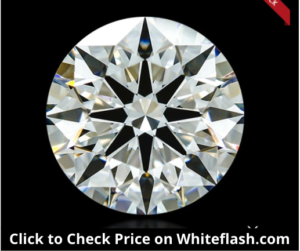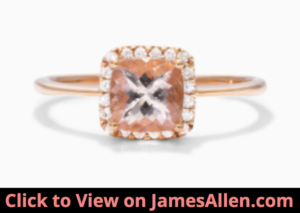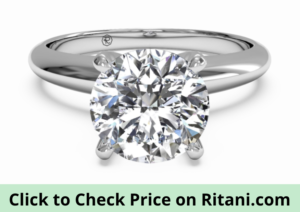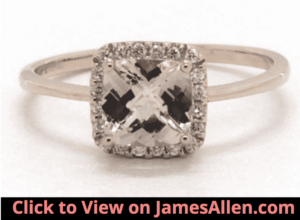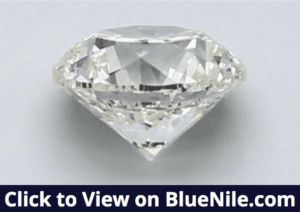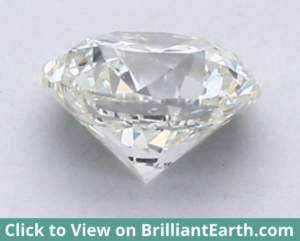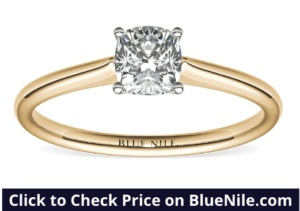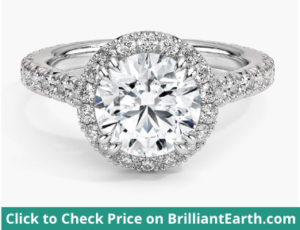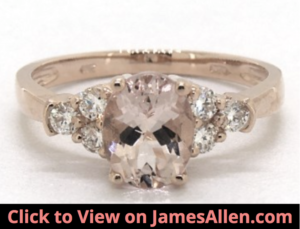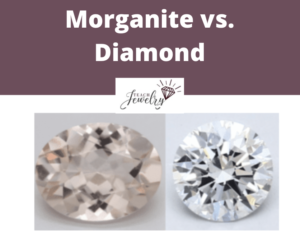
Most fine jewelry features a glimmering diamond, but in recent years, unique gems have gained popularity as a way to stand out from the classic looks.
One example is morganite, known for its transparent pink color and near-perfect clarity.
The main differences between morganite and diamond are its structure and color. While morganite is a shade of pink that is a type of beryl, diamond consists of a single element and is most often colorless or features a yellow tint.
Let’s compare morganite versus diamond to help decide which is right for you, including an overview of each and how they differ in areas such as brilliance, durability, price and more.
What is Morganite?
Morganite is a pink gemstone closely related to aquamarine and emerald. The mineral includes both of these stones, making it part of the beryl family.
In its most valuable form, it’s a dark shade of pink, but it can also come in brighter pink, rose, and coral.
It was discovered in 1910 in Madagascar by the chief gemologist at Tiffany & Co., George F. Kunz. Kunz was the personal gemologist of the famous banker J.P. Morgan, and the stone was named in his honor.
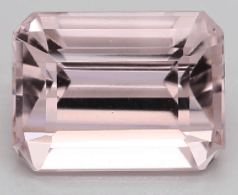
Today, it’s mined in many places around the world but primarily in Brazil and Madagascar.
Morganite is often found with a natural yellow or orange tint, so it’s heat-treated to rid the gem on these tones.
This treatment isn’t noticeable and results in a more pure pink, so it’s less liable to fade over time.
It’s become more popular as an engagement ring because of its lower price per carat and modern aesthetic that deviates from traditional engagement ring styles.
What is a Diamond?
Diamonds are formed more than 100 miles below the earth’s surface. It’s the only known gem, with the exception of graphite, that’s made from a single element.
They’re mined around the world, but countries such as Russia, Botswana, Australia, and Canada produce a significant percentage of the supply.
As you can see in the example below, they consist of sparkling facets that collect and return light to the viewer.
For at least the last 75 years, diamonds have been the most popular gem used in proposals.
But just because you’re choosing a diamond to sit atop a ring doesn’t mean your options are limited.
The most prized diamonds are colorless, inclusion-free gems with high carat weights and quality round cuts, but younger generations have shifted from this style to different shapes, colors, and settings.
How are Morganite and Diamond Different?
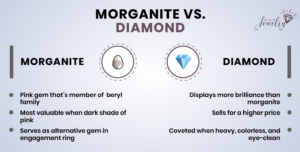
Before you choose between morganite and diamond, it’s important to understand the distinctions between these two gems.
Depending on your choice, you’ll have a vastly different look, choice of settings, total cost, and more.
Here are 11 differences to know.
1. Density
Morganite is less dense than a diamond. This is important in comparing the size of morganite versus diamond.
Morganite has a density of 2.71 to 2.90, while diamond’s density is 3.5. That means if you picked up morganite and diamond of the same size, the diamond could be anywhere from 15-30% heavier.
You won’t notice this difference when wearing your jewelry.
For example, the ring below includes morganite at its center surrounded by diamonds.
If you switched their positions, you wouldn’t notice a heavier weight on your finger. The relative weights are too light.
But when choosing the carat weight of either morganite or diamond, it’s not an exact comparison.
The morganite would have to be larger in size to equal the carat weight of the diamond. For a more direct comparison, measure their diameters in millimeters, which is how you’ll typically find morganite listed.
2. Brilliance
If you’re comparing the brilliance of morganite versus diamond, there’s an easy answer: Diamonds display more brilliance.
Their sparkle and glimmer are what has made it a focal point of the jewelry industry. It’s often the quality consumers care most about and is why retailers charge a premium for colorless diamonds with an excellent cut.
Those characteristics enhance a diamond’s brilliance more than any other.
To illustrate, the diamond below has an ideal cut with an F color and VS1 clarity grade.
You can expect it to exhibit a high degree of brilliance, fire, and scintillation because of those three attributes.
The light performance of a diamond is measured by its refractive index.
The refractive index indicates how fast light travels through a diamond compared to the speed of light through air.
A diamond’s refractive index is 2.417, which means it travels through a diamond 2.417 times slower than through air.
Morganite’s refractive index is between 2.71 and 2.90.
One of the pros of morganite is its brilliance is more pronounced compared to other pink stones, but it pales in comparison to a quality diamond.
In general, large morganite stones display more brilliance than smaller ones.
3. Harness and Durability
The Mohs scale of mineral hardness grades the scratch resistance of various minerals to determine their hardness and durability.
Diamonds score a perfect 10, making it the hardest naturally-occurring mineral on Earth. Morganite is a 7.5 to 8.
That doesn’t mean morganite is 75-80% as durable as diamond because the scale increases exponentially. In reality, diamonds are six to eight times harder than morganite.
You can still expect morganite to last for years with proper care, even if you wear it every day.
If you drop on the ground, it likely won’t break, although if it’s hit against a hard surface, you would need the right setting to protect it.
That being said, some vendors recommend you don’t wear morganite rings every day, but that’s more about taking extra precaution rather than forecasting it could easily deteriorate or break.
Remove it during physical activity, but as a fashion piece, it’s at minimal risk of damage.
4. Price
Diamond is more expensive than morganite, primarily a result of demand.
Morganite is actually more rare to find, but because it isn’t as popular of a gem for jewelry, it doesn’t come at a premium compared to diamonds.
A diamond of decent color, cut, and clarity sells for about $3,000 per carat. Morganite sells for $300-$500 per carat, based on its quality.
If you’re interested in a more affordable option for your fine jewelry or engagement ring, choosing morganite as the primary gem will help you save on cost compared to diamond. You can also put that savings toward a larger gem or an improved setting.
For example, this 0.85 carat halo morganite and diamond ring sells for $820.
It includes the 14K rose gold band and small diamond accents around the center morganite.
And the below one-carat round cut diamond sells for $2,940.
It’s an excellent cut, J color, and SI2 clarity. There are diamonds with the same carat but better color, clarity, and cut that cost between $4,000-$6,000, and some of lower quality that are closer to $2,500.
In many cases, you won’t see morganite measured in carats. Instead, its dimensions are measured in millimeters. For example, the oval morganite gem in this morganite and diamond halo ring measures 11×9 millimeters.
5. Color
Color is the most apparent distinction between morganite and diamond.
If you’re buying morganite, it’s likely the shades of pink that draw you to it versus the colorless or yellow shade of a diamond.
Even though it’s most commonly thought of as pink, the color of morganite can range from violet-pink and peach to rose and purplish, all in various levels of intensity. The most valuable ones are a dark shade of a pink.
Take a look at the image below of three different shades.
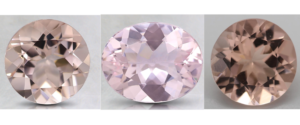
On the left is peach morganite. It’s still slightly darker than the oval morganite in the center, but neither match the deep pink of the morganite on the right.
Diamonds are graded on a color scale from D (colorless) to Z (light). Diamonds graded D are the most valuable because they have the strongest light performance, and as you move down the scale, there’s a stronger presence of yellow and brown.
You don’t have to choose a D diamond for it to appear colorless to the naked eye. For example, the diamond below earned a G color grade, which is the “near colorless” category. But its tints of yellow are so minor they aren’t even visible in the high-resolution image.
Diamonds do come in colors other than colorless, yellow, and brown. These are known as fancy colors and include black, green, purple, orange, and even pink.
Although a pink diamond and morganite may look similar at a glance, they’re unique gems that have many other distinguishing qualities.
6. Shapes
Both morganite and diamond come in similar shapes. Round is the most popular shape for each, but you can also buy them in:
- Princess
- Emerald
- Oval
- Pear
- Cushion
The morganite below are cushion, pear, oval, and round cuts.
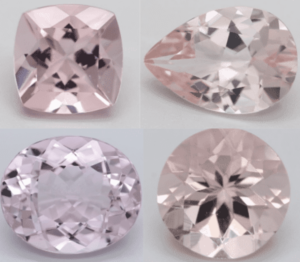
Each of these shapes offer a unique style and performance.
Brilliant cut diamonds, like round, princess, and marquise cuts, demonstrate strong brilliance because of their kite-shaped facets.
Shapes like princess and cushion offer a squarish appearance distinct from a round cut but still have exceptional light performance.
Emerald, oval, and pear don’t return light as well but are a unique, modern shape that’s set apart from a traditional round cut. Their step-cut facets are elongated across the diamond and produce a subtle glow.
7. Clarity
Clarity refers to the number, size, and position of inclusions in a gem. Inclusions are imperfections such as feathers, cloudiness, or crystals lodged inside that diminish its cleanliness and inhibit brilliance.
You’ll pay significantly more for a gem that’s flawless versus one that’s filled with inclusions.
Morganite naturally has strong clarity. It rarely forms with significant inclusions, and inclusions that do develop often aren’t visible with the naked eye, resulting in a transparent gem.
The GIA and similar institutions don’t formally grade the clarity of morganite, so the degree of cleanliness in a given gem is up to the eye test. Fortunately, most morganite passes.
You can see in the GIA Colored Stone Identification report below that clarity and inclusions are nowhere to be found.
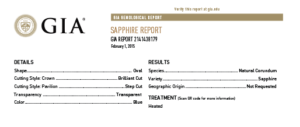
On the other hand, a flawless diamond is a rare find. That’s why many shoppers don’t worry about finding one that’s flawless and instead focus their efforts on eye-cleanliness.
Diamonds scoring at least an SI1 on the GIA clarity scale are often eye clean. For diamonds of a higher carat weight, it may require a VS2 grade to avoid seeing inclusions.
You can learn how the inclusions affect its overall appearance and performance by examining the diamond in person or through a high-resolution image, followed by reading its grading report.
To illustrate, this 1.07-carat diamond was graded by the GIA. Even the magnified image doesn’t show inclusions.
But by assessing the report below, we can identify twinning wisps, crystals, and needles and where they’re located.
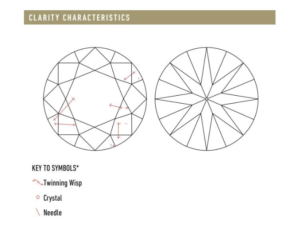
The conclusion is that although there are several inclusions present, they won’t impact its appearance or durability in a significant way.
The clarity of morganite provides it another advantage on price. For example, the price difference between a SI1 clarity diamond and a VVS2 (very, very slightly included) is 40%-50%, with all other qualities of the diamond being equal.
The natural cleanliness of morganite allows you to avoid that premium while still having strong clarity.
8. Grading Reports
A grading report on a gem is about gaining confidence its quality matches what the salesperson tells you.
There are many organizations that grade gems, but not all are considered rigorous. The gold-standard is the GIA, famous for developing the four Cs of clarity, cut, color, and carat.
The GIA grades diamonds but only evaluates morganite. The distinction is diamonds are given a comprehensive report detailing where it lands on the four Cs and other measures of quality such as fluorescence, symmetry, and the types of inclusions it holds.
The GIA’s evaluation of morganite instead answers the following questions:
- How much does it weigh?
- What color is it?
- Is it natural or lab-grown?
- Has it been treated?
If you’re spending a significant amount on a piece of morganite, you should know the answers to these questions. A GIA report is a reliable way to do so.
9. Settings
The setting of a ring is what holds the center gem. Most buyers focus their time on finding the right diamond or other gemstones, but you shouldn’t ignore the affect a quality setting has on the piece.
The most popular setting for a diamond ring is a solitaire setting with prongs, which consists of a single diamond on top held in place by each corner.
Another style is called a halo setting, where a small ring of diamonds circles the main one.
Check out the halo setting below, which also includes pave diamonds on the shank.
The piece will sparkle from every angle because of the additional diamonds.
Both diamonds and morganite pair well with a variety of settings. Diamonds are often included in morganite’s setting.
For example, this ring features an oval-shaped morganite gem at its center, flanked on both sides by three round diamonds.
It’s rare to see the opposite, where a center diamond is surrounded by morganite. Morganite isn’t generally used as accents, so if it’s placed in a setting, it’s almost always in the center.
Platinum, rose gold, and gold bands complement morganite. While rose gold mimics the color of morganite, platinum and gold offer a unique contrast to its pink shade.
10. Style
There’s another reason diamond reigns as the most popular gem, especially for engagement rings. It goes with any personal style. Its colorless look matches any outfit, and an added shine is always a welcome addition.
It’s expected to be worn in both casual and classy settings, so you don’t have to think twice about whether the occasion is right for a diamond.
Morganite’s pink shade, on the other hand, is fit for some styles but not for all. It pairs best with a dark outfit or one that matches its pink. In more formal settings, it’s also worn as stud earrings or a pendant.
11. Cleaning and Care
You can clean and care for diamonds and morganite in the same way. Avoid your gems coming into contact with harsh chemicals from household cleaning products.
When you’re getting dressed, put the jewelry on last so it doesn’t get covered with lotions, perfume, or makeup.
Clean your diamond or morganite at least once per year, but every six month helps keep their shine in top shape.
Both can be cleaned with warm, soapy water. Place a few drops of mild dishwashing soap in a bowl of water, and rinse the gems.
You can gently brush each with a soft toothbrush to clear debris or dirt in and around their settings.
Pat them dry with a soft cloth.
Diamonds can be cleaned in ultrasonic cleaners, and morganite is generally safe. If it has large inclusions or fractures, you should play it safe and wash it by hand.
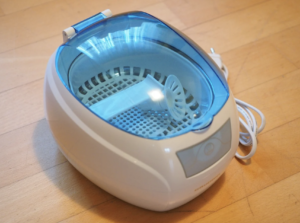
While diamonds are less susceptible to scratching, you should store morganite separately from other gems so they don’t rub against each other.
For extra precaution, wrap it in a soft cloth and place it in a jewelry box lined with fabric.
What to Look for When Buying Morganite
The most important aspects to consider when buying morganite are:
- price
- size
- color
- clarity
- type of jewelry
When it comes to price, you can set a lower budget than if you were buying a diamond. You can purchase a sizable morganite gem, including its setting, for less than $1,000.
The color is generally stronger for larger pieces of morganite. The most coveted ones are a dark pink, and it’s rare to find this shade in a small gem.
You also shouldn’t have to look too hard to find morganite with strong clarity. Most are eye-clean, so you can focus your attention on the other qualities.
Morganite is available for many types of jewelry, such as rings, necklaces, earrings, and bracelets. Each offers their own style and can complement the looks of your other jewelry.
For example, you may not want to wear a morganite ring next to your diamond ring because they’ll compete with each other.
Instead, wear morganite earrings with your colorless diamond ring.
What to Know When Buying a Diamond
Spend more time searching for the right diamond.
It’s a much larger investment than morganite. Focus on the four Cs, which qualities are most important to you, and how those qualities impact price.
We recommend finding a diamond with a clarity that’s eye-clean. In most instances, this means an SI1 clarity or above.
Most want a diamond that appears colorless to the naked eye. You’ll pay a premium for a diamond graded D-F because they earn the official “colorless” grade.
For the best value, choose one graded H or G. They’ll likely appear colorless but for a lower price.
With an H color grade an VS2 clarity, it avoids the higher prices charged for colorless grades and ones on the high end of the clarity scale.
The same principle applies for carat.
There’s a premium price for a diamond that reaches one carat, so finding one between 0.80-0.99 carats means it’ll look almost identical to a one-carat diamond without the price increase.
Cut is considered the most important of the four Cs because it has the most significant effect on light performance.
Excellent cuts are the most expensive, but it’s worth the cost because of the way it improves the diamond’s light performance.
Is Diamond or Morganite Right For You?
Understanding the differences between diamond versus morganite is key to making the right choice between these two popular gems.
Here are some tips on how to decide.
Consider a diamond if:
- You want a traditional ring with the most popular gemstone
- You’re willing to pay a premium for a diamond over other stones
- You spend time searching for a diamond that’s eye-clean and appears colorless and avoid paying for features that aren’t noticeable
Morganite might be right for you if:
- You’re interested in an alternative to the classic gemstone used in jewelry
- You want to save money and choose a larger piece than what you could afford for a diamond
- It’s appealing to have a piece of everyday jewelry such as an earring or necklace that pairs best with specific attire
Whichever you choose, compare multiple options that have various colors, clarity and more, and with the right pick, you’ll have a diamond or morganite that complements your style.

Jacob Clarke
Jacob Clarke is the founder of TeachJewelry.com.
He earned an Applied Jewelry Professional Diploma from the Gemological Institute of America (GIA) and now brings you essential information about diamonds, settings, and more.
Jacob has consulted with leading jewelry brands, and his work has been cited in Clean Origin, Diamond Nexus and industry publications.
He's also a member of the International Gem Society.
He enjoys discussing jewelry with readers, so contact him with any questions at jacob.clarke@teachjewelry.com.

